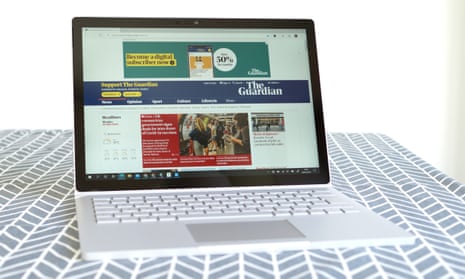Microsoft’s unique power-laptop with detachable tablet screen is back for its third iteration, and other than new chips nothing has changed.
The Guardian’s product and service reviews are independent and are in no way influenced by any advertiser or commercial initiative. We will earn a commission from the retailer if you buy something through an affiliate link. Learn more.
Costing from £1,599, this isn’t your average laptop or tablet. The Surface Book 3 is Microsoft’s workhorse for those who need oodles of power, available in a 13.5in version (as reviewed here) and a larger 15in version.
Over four years and three main releases the Surface Book 3 really hasn’t changed. Compared with 2017’s Surface Book 2, the new Surface Book 3 has the exact same design, dimensions and weight.
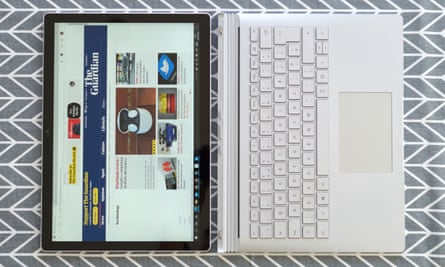
You can’t tell the difference between them, nor the first generation machine from 2016.
It still looks like nothing else on the market, with a screen that detaches turning into a tablet with (optional, £99.99) stylus clipped to the side.
The fulcrum hinge still stands out from the crowd, but what looked wild and innovative in 2016 looks big and bulky by 2020’s standards. The Surface Book line is in need of some modernising.
Not that the Surface Book 3 functions poorly. The keyboard is still fantastic, and with 1.55mm of key travel it feels almost sumptuous compared with many. The trackpad looks a little small in the deck, but works great. It clicks very loudly though, which has annoyed my fellow home-workers.
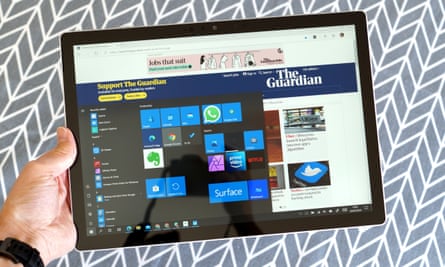
The screen is still crisp, bright and beautiful – and now detaches significantly faster. Taking it off to go show someone something, or to annotate a document, watch a movie or just browse the web is still a great experience. As is the ability to dock it in reverse to the laptop deck and fold it down like a drafting board.
At 1.5kg to 1.6Kg in weight, Surface Book 3 is heavier than most of its 13in competition. The 13in MacBook Pro weighs 1.4Kg, while Dell’s XPS 13 weighs just 1.27Kg. Neither of those machines have a discrete graphics card; that sort of horsepower is mainly reserved for gaming laptops or larger 15in plus machines, such as Apple’s 16in MacBook Pro, which weighs in at 2Kg.
Specifications
Screen: 13.5in LCD 3000 x 2000 (267 ppi)
Processor: Quad-core Intel Core i5 or i7 (10th generation)
RAM: 8 or 16GB
Storage: 256, 512 or 1TB
Graphics: Intel Iris Plus + Nvidia GeForce GTX 1650 (4GB)
Operating system: Windows 10 Home
Camera: 8MP rear, 5MP front-facing
Connectivity: Wifi 6, Bluetooth 5, 2x USB 3.1, 1x USB-C, SD, Surface Connector, headphones
Laptop dimensions: 232 x 312 x 23mm
Laptop weight: 1.534 or 1.642Kg
Tablet weight: 719g
Graphics power and work-day battery

The Surface Book 3 has Intel’s 10th-generation Core i5 or i7 processors, with the later models also shipping with an Nvidia GeForce GTX 1650 discrete graphics processor. The main processor, RAM and storage live in the screen of the Surface Book 3, with the graphics card in the laptop deck.
That means you can pull the screen off, and other than the increased performance of the Nvidia GPU, you have the entire computer. But it’s also worth noting that processors in the Surface Book 3 are only the quad-core variants, which are used in most ultrabooks.
That includes the 13in MacBook Pro and Dell XPS 13, and Microsoft’s cheaper Surface Laptop 3, but workstation laptops typically use more performant six or eight-core Intel chips.

The reason quad-core chips are used in the Surface Book 3 is that they have to fit in the thin, compact tablet section, which limits the amount of power and heat you can have. Still, the quad-core power in the Surface Book 3 is more than enough for most users, particularly those who rely more on the graphics card, such as creatives or gamers. Only developers or those that need a lot of computing power over an extended period of time will really max out the machine.
The port selection includes the Surface Connect port, that is used for power but also connectivity via the Surface Dock or adapters; two USB-A ports, which are a rarity in 2020; a full-size SD card reader; headphones socket in the tablet part and a single USB-C port. Having only one USB-C port is disappointing for a powerful machine, as is the lack of Thunderbolt 3 support, which is now standard across most Windows laptops.
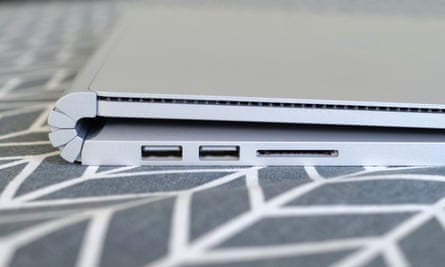
The Surface Book 3 has two batteries that work together: one in the screen and one in the laptop deck. Combined they last up to 8 hours 30 minutes between charges, using Chrome, Windows Mail, Evernote, NextGen Reader, Typora, several messaging apps, plus an hour of image editing in Affinity Photo. That’s enough for a full work day, matching the Surface Laptop 3; good but not class leading. Using the Nvidia GPU will significantly reduce battery life.
With the included 102W charger, the Surface Book 3 fully charged in just more than three hours while under light use. The laptop can be charged via USB-C too, while the tablet can be charged on its own via the Surface Connect port.
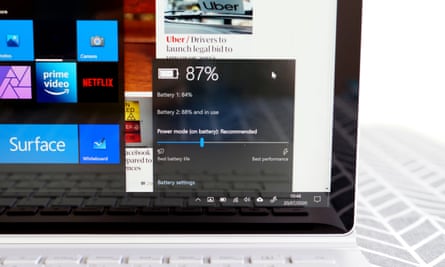
Sustainability
The Surface Book 3 is one of the more difficult of laptops to get fixed due to its construction – it’s similar to the Surface Book 2, which repair specialists iFixit gave a score of just one out of 10.
Microsoft does not provide an estimate for the expected number of full charge cycles from the Surface Book 3’s batteries, which is typically 500 while maintaining at least 80% capacity. The batteries in each part of the machine are not user replaceable. Repairs must be performed by authorised service providers. The out-of-warranty service fee, regardless of what is wrong, for the Surface Book 3 from Microsoft is £568.80.
Microsoft did not comment on whether the machine contains recycled materials, but the company operates trade-in and recycling schemes for old machines.
Windows 10 Home
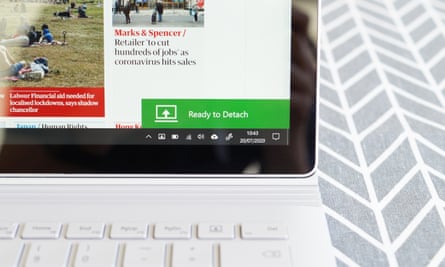
Despite being a power machine, the Surface Book 3 ships with Windows 10 Home for consumers. It is the same version that ships on the Surface Laptop 3 and Surface Pro 7, which includes device encryption to protect your data if the laptop is stolen.
On the whole, Windows 10 is a solid and reliable operating system on the Surface devices. In the two weeks of testing, the Surface Book 3 ran smoothly with no software or hardware issues. But it’s worth noting that Microsoft has delayed the release of some of its key feature updates for Surface devices. For the whole of the review period the Surface Book 3 was prevented from installing the Windows 10 2004 update, which was released at the end of May.
Observations
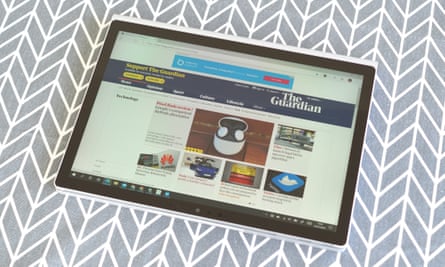
The screen wobbles a bit if poked when in laptop mode.
Both the mics and camera are really good for video conferencing.
The speakers are loud, projecting forward from the screen and very good for a laptop.
Price
The 13.5in Microsoft Surface Book comes in four configurations. The starting model has an RRP of £1,599 with an Intel Core i5 processor, 8GB RAM and 256GB SSD.
The Intel Core i7 versions, which all have the Nvidia GeForce GTX 1650 discrete graphics processor, start at £1,999 with 16GB RAM and 512GB SSD, £2,449 with 32GB RAM and 512GB SSD and £2,699 with 32GB RAM and 1TB SSD.
A 15in Surface Book is also available, starting at £2,199.
Verdict
The Surface Book 3 is a strange machine. It is unlike any other laptop, hybrid or tablet PC, essentially being a combination of all three: a proper articulated laptop with the screen docked and a full tablet when the screen is undocked.
But that unique ability hampers it in ways that might be a deal-breaker for an expensive workstation laptop bought for heavy-duty computing. These include it shipping with only quad-core processors and reduced thermal capacity due to most of the important bits being in the screen section that’s more difficult to cool. It’s also bigger and heavier than competitors with 13in screens, being closer in size to most 15in laptops.
That’s not to say the Surface Book 3 isn’t a powerful computer. It is a better proposition for consumers or creatives due to that tablet mode, excellent stylus support, Microsoft’s brilliant Surface Dial accessory and the dedicated graphics card in most models.
The screen is great, the new chips are quite a step up over the previous version, battery life is solid but not class leading and the typing experience is still great. But the Surface Book line is starting to look tired and in need of a new, more functional design.
The excellent Surface Laptop 3 is a better buy for most people, but if you really want a laptop you can take the screen off or need more graphics power, then the Surface Book 3 is a capable machine.
Pros: excellent keyboard, great trackpad, brilliant screen, great stylus, good performance and battery life, Nvidia GeForce GTX 1650 discrete GPU, SD card slot, good cameras and mics, Windows Hello, screen comes off.
Cons: expensive, no 6 or 8-core processor options, relatively big and heavy, no Thunderbolt 3, only one USB-C.
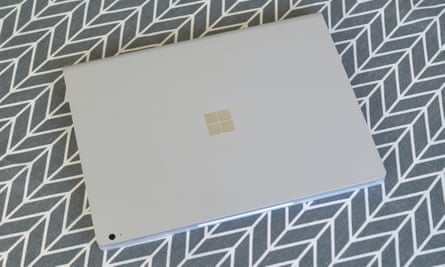
Other reviews
Microsoft Surface Laptop 3 review: still sleek, just no longer unique
Microsoft Surface Pro 7 review: the best Windows 10 tablet PC you can buy
Surface Go 2 review: Microsoft’s smaller, cheaper Windows 10 tablet
Microsoft Surface Pro X review: not yet ready for prime time
Huawei MateBook X Pro review: Windows 10’s MacBook Pro rival
16in MacBook Pro review: bigger battery, new keyboard, new Apple
